Replay Review Process: Key Steps, Best Practices, and Rules
Updated On: October 21, 2025 by Aaron Connolly
Defining the Replay Review Process

The replay review process gives officials a systematic way to examine disputed calls with video technology. They use video evidence analysis to overturn, confirm, or let stand the original call—so long as the footage gives clear proof.
Core Principles and Objectives
Three main principles shape how we look at disputed calls in sports today.
Accuracy comes first in the replay process. Officials check several camera angles to get the call right instead of rushing. Most leagues let them take up to two minutes for a standard review.
Clear and convincing evidence must exist to overturn a call. If the video leaves any doubt, the original decision stands. That rule keeps endless arguments over close calls in check.
You see this play out during tight tag plays at second base. The replay official has to spot clear proof that the runner beat the tag or that the fielder missed the base.
Finality keeps the game moving after reviews. Once the replay official decides, that’s it—no more challenges or protests. Teams can’t argue calls forever.
Time limits and challenge restrictions help this process. Most teams get one or two challenges per game, so managers have to pick their spots for crucial plays.
Role of Video Evidence
Video evidence forms the backbone of every replay decision. It’s completely changed how we judge disputed calls in competitive sports.
Multiple camera angles cover every reviewable play from all sides. Modern stadiums usually have 8-12 cameras set up around the field, each catching a different view.
High-speed cameras record at 240 frames per second. That lets officials see the exact moment a ball crosses a line or a runner’s foot hits a base.
Replay officials check footage frame by frame with special equipment at centralized review centers. In baseball, they work from MLB’s headquarters in New York. NFL reviews happen at Art McNally GameDay Central.
The tech includes zoom and frame-by-frame tools. Officials can focus on specific moments and compare angles side by side.
Audio communication keeps replay officials in touch with on-field umpires during reviews. That way, everyone stays on the same page, and player positioning gets fixed after overturned calls.
Evolution Across Football and Other Sports
Replay technology didn’t develop the same way in every sport. Each one tweaked the process to match its own pace and needs.
Baseball started with limited replay in 2008, just for home run calls. By 2014, the system covered force plays, tag plays, and boundary calls.
American football got into instant replay earlier, back in the 1980s. The NFL now lets coaches challenge certain plays with those famous red flags.
Soccer’s VAR (Video Assistant Referee) reviews goals, penalties, red cards, and mistaken identity. It’s the newest major league to embrace replay tech.
Every sport faces different hurdles with replay. Baseball’s slower pace fits longer reviews, but soccer has to balance accuracy with keeping the game flowing.
Review protocols look different across sports. Some allow unlimited reviews by officials, while others limit challenges to keep things strategic and avoid too many delays.
Technology keeps moving forward. Now there are automated systems for some calls—like tennis’s Hawk-Eye for line calls and cricket’s ball-tracking for LBW decisions.
How the Replay Review Process Works
The replay review process gives managers or officials a way to challenge calls. Specialized replay officials in New York make the final decision. The process usually takes less than two minutes and follows set protocols for starting reviews and deciding outcomes.
Initiating a Review
Managers have 15 seconds after a play ends to signal for a replay review. They raise a hand or step out of the dugout to show they want a challenge.
Each manager starts the game with one challenge. If their first challenge works and the call gets overturned, they keep their challenge for later.
From the eighth inning on, crew chiefs can start reviews themselves. They don’t need a manager’s challenge for this. That rule makes sure late-game calls get a closer look.
Crew chiefs can always review potential home runs—no challenge needed. This rule applies all game long.
The umpire crew chief announces the challenge over the stadium speakers. They say which team asked for the review and what specific call is under review.
Decision-Making Protocols
All replay reviews happen at the Replay Command Center in New York. Full-time Major League umpires work there, in addition to their regular on-field jobs.
The replay official checks all the video footage with a technician’s help. They look for clear and convincing evidence to change the original call.
Three things can happen:
- Confirm the original call
- Overturn the original call
- Let the call stand if there’s not enough evidence
Replay officials have to decide within two minutes, most of the time. This keeps the game moving.
Once the replay official decides, that’s final. No more appeals or protests. Players or coaches who keep arguing after the decision might get tossed from the game.
Roles of On-Field and Replay Officials
On-field umpires make the first calls and manage the replay process. The crew chief uses a microphone to talk to fans and the broadcast.
They announce when a review starts and explain the final decision. That way, everyone in the stadium and at home knows what’s going on.
Replay officials in New York make the final call. They’re experienced umpires who know the rules inside and out. They work shifts at the command center but still do regular on-field games.
If a call gets overturned, the replay official decides where to put the runners. They try to put teams back where they would have been if the right call happened at first.
Managers can change their strategy after an overturned call. For example, if they pulled a pitcher based on a bad call, they can rethink that move after the correction.
Reviewable Plays in Football
Football replay officials can review certain types of plays to make sure on-field calls are right. These include scoring decisions near the goal line, pass completions, ball possession changes, and player position near boundaries.
Scoring and Goal Line Decisions
All scoring plays get reviewed automatically in football now. That covers touchdowns, field goals, and safeties.
Goal line decisions always get a look from instant replay. Officials check if the ball crossed the goal line before a player was ruled down.
The ball’s position near the goal line gets a lot of attention during reviews. Video evidence has to give clear proof to overturn the call.
Key scoring plays reviewed:
- Touchdown catches in the end zone
- Running plays near the goal line
- Field goal attempts that are close
- Two-point conversion tries
Pass Completion and Incomplete Passes
Incomplete pass calls get reviewed a lot. Replay officials can fix obvious mistakes fast when the ball clearly hits the ground.
The replay process checks three things for pass plays. Did the receiver control the ball? Did both feet land inbounds? Did the player keep possession through the catch?
Modern rules let booth officials help out when video clearly shows an incomplete pass was ruled a catch. That keeps the game moving and skips long challenge delays.
Officials also look at whether receivers had possession before fumbling. The exact moment of control decides if it’s a catch or incomplete.
Loose Ball and Possession Calls
Loose ball possession is reviewable when the video shows which team recovered first. This covers fumble recoveries and onside kicks.
Replay officials check if a player was down by contact before losing the ball. If a knee or elbow touched while being tackled, the play ends there.
They also review if the ball touched a player, the ground, or a boundary during loose ball plays.
Common loose ball reviews:
- Fumble recovery in pile-ups
- Onside kick possessions
- Muffed punt recoveries
- Player down by contact
Boundary and Line of Scrimmage Rulings
The line of scrimmage and player position get a lot of attention in reviews. Officials check if players lined up right or if the ball reached the line to gain.
Boundary calls get reviewed when players are close to sidelines or goal lines. Video must show clearly if a player stepped out or if the ball crossed the line.
Spot of the ball decisions are reviewable for first downs or field position. Replay officials can move the ball if the video proves the spot was wrong.
Game clock issues also get reviewed. Officials fix timing errors if the video shows when a player went out or when a play ended.
NFL Replay Review Rules
The NFL runs a system where some plays get reviewed automatically, while others need a coach’s challenge. Newer rules let replay assistants fix obvious mistakes even faster, sometimes without stopping the game at all.
Automatic Vs. Coach-Initiated Reviews
The NFL automatically reviews some plays—no coach needed. These include scoring plays, turnovers, plays inside the two-minute warning, and overtime plays.
Coaches can challenge other plays by throwing a red flag. Each team gets two challenges per game. If they win both, they get a third.
The replay assistant can buzz the ref during the last two minutes if they spot a clear error. That helps fix big mistakes quickly.
Coach Challenge Rules:
- Throw the flag before the next play starts
- Lose a timeout if the challenge fails
- No challenges during the final two minutes
- Must have timeouts left to challenge
Reviewable vs Non-Reviewable Penalties
Most penalties stay off-limits for instant replay. The NFL leaves those as judgment calls for on-field refs.
But the replay assistant can now overturn some specific calls without a full review. This covers clear cases where officials missed something obvious.
Reviewable:
- Player stepped out of bounds
- Forward pass vs lateral pass
- Player down by contact
- Fumble recovery
Not Reviewable:
- Holding penalties
- Pass interference
- False starts
- Most judgment-based fouls
Recent Updates and Rule Changes
The NFL expanded replay assistance to speed things up. Replay officials can now advise field crews about clear mistakes without a full stoppage.
New tech at Art McNally GameDay Central helps reviews go faster. The system connects New York replay officials with every NFL stadium.
These changes have cut down on formal challenges and booth reviews. Games flow better now, with fewer long stoppages.
Key 2024-2025 Changes:
- Replay assistants have more authority
- Faster communication systems
- More plays fixed without full reviews
- Fewer game stoppages
Utilising Video Evidence
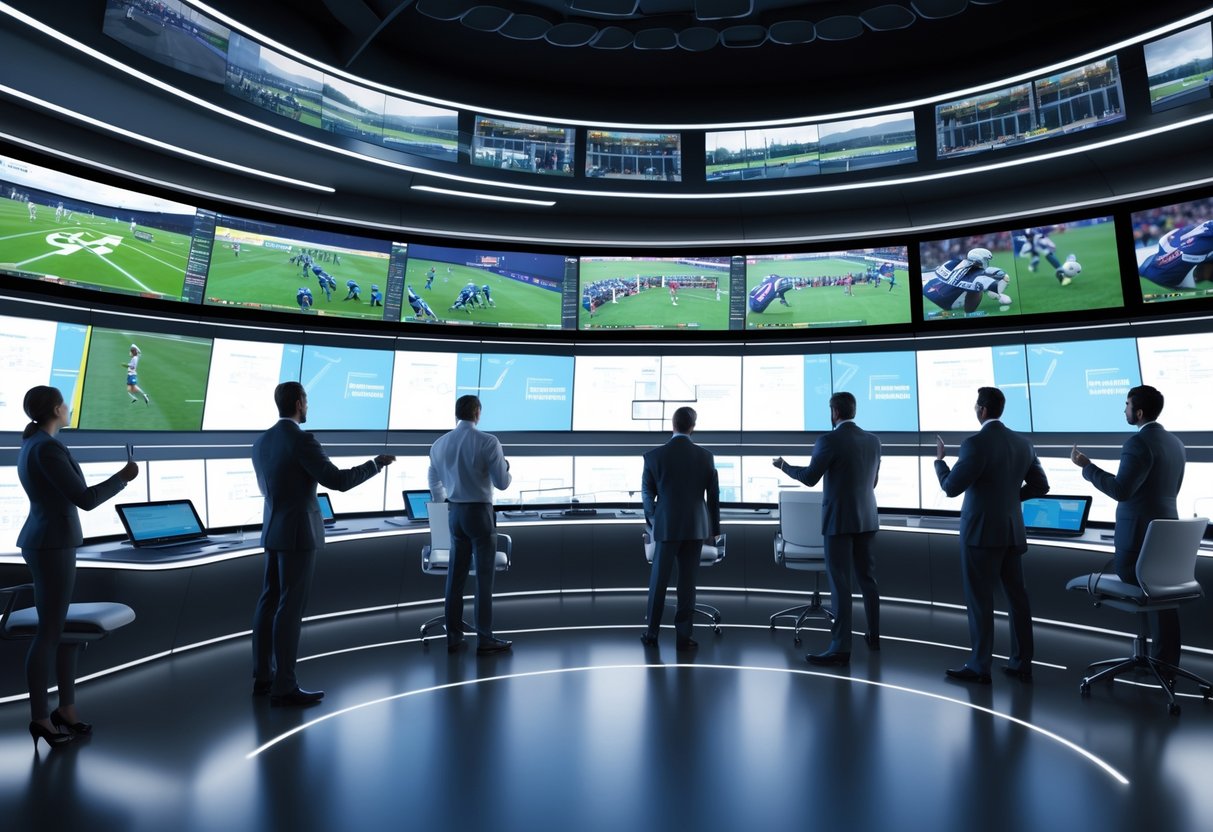
Video evidence is the backbone of replay decisions in modern esports tournaments. Officials use multiple camera angles and advanced technology to decide if on-field rulings should stand or get overturned, always looking for clear visual proof.
Criteria for Overturning On-Field Rulings
Tournament officials stick to strict guidelines when they review video to overturn initial decisions. The original ruling still matters a lot during this process.
Primary Requirements:
- Visual proof must directly contradict the original call
- At least one camera angle needs to show this evidence
- The incident has to fit within reviewable categories
We usually see overturns only when the video clearly shows the opposite of what the officials called at first. If the footage is fuzzy or unclear, reversals almost never happen.
Common Overturn Scenarios:
- Officials blame the wrong player for eliminations
- Referees miss objective captures
- Equipment malfunctions mess with gameplay
- Rule violations slip by in real time
Tournament organisers keep databases of overturned calls to help improve officiating in the future. This data points out patterns where video evidence most often contradicts initial rulings.
Technology and Camera Angles
Modern esports venues set up advanced camera systems to catch every angle of play. Officials can check incidents from several viewpoints.
Standard Camera Setup:
- Player perspective cameras (each player’s screen)
- Overview cameras (full stage view)
- Audience reaction cameras
- Equipment monitoring cameras
High-speed cameras capture those tiny, critical moments that decide matches. Some of these systems shoot up to 240 frames per second for detailed, frame-by-frame review.
Technology Requirements:
| Equipment | Purpose | Frame Rate |
|---|---|---|
| Player cams | Individual gameplay | 60 FPS |
| Stage overview | Team coordination | 30 FPS |
| High-speed | Critical moments | 240 FPS |
| Equipment monitor | Hardware issues | 30 FPS |
Tournament producers work closely with broadcast teams to make sure instant replay systems catch all the right angles. This teamwork helps avoid missing key moments.
Standard of ‘Clear and Obvious’
The ‘clear and obvious’ standard stops officials from overturning calls on weak or marginal video evidence. It protects the weight of original decisions but still lets officials fix clear mistakes.
Clear and Obvious Criteria:
- Definitive proof: The video must show undeniable evidence
- Multiple angles: Confirmation from different camera views
- Technical clarity: Footage needs to be high quality and unobstructed
- Timing accuracy: The disputed moment must be captured precisely
Officials go through extensive training to apply this standard the same way at every tournament. They learn to spot obvious errors and ignore calls that are just open to interpretation.
Review Process Timeline:
- Initial review (30 seconds): Officials do a quick look at the footage
- Detailed analysis (2 minutes): They go frame by frame if needed
- Final decision (30 seconds): Match officials confirm the outcome
Tournament rules set maximum review times to keep matches moving. Only championship-deciding moments or major violations get extra time.
Over the years, this standard has kept changing as video tech gets better. Officials now have clearer footage and more advanced tools to help them out.
Review Process for Scoring Plays
Replay officials automatically review all scoring plays in football. They check touchdowns, field goals, and extra points before any points hit the scoreboard.
Goal Line Technology
Football doesn’t use the same goal line tech as some other sports. Instead, replay officials rely on multiple camera angles to see if the ball crossed the goal line.
The biggest challenge usually happens right at the goal line. Officials need clear proof that the ball broke the plane while the player still had possession.
Camera angles used include:
- Pylon cameras at each corner
- Overhead goal line cameras
- Sideline cameras for different views
- End zone cameras behind the posts
Replay officials get 90 seconds to decide. They also work with Art McNally GameDay Central in New York to look at all the footage.
The ball just needs to cross the goal line by the tiniest bit. Even if a player gets pushed back right after, the touchdown stands once the ball breaks the plane.
Touchdowns and Field Goals
Touchdown reviews always focus on three things: possession, ball placement, and if the player was down before scoring.
For rushing touchdowns, officials check if the ball crossed the goal line. On passing plays, they make sure the receiver caught the ball in bounds with both feet down.
Common touchdown review scenarios:
- Fumbles near the goal line
- Tight catches in the corner of the end zone
- Players stepping out of bounds
- Whether a runner was down before scoring
Field goal reviews look at whether the ball went between the uprights and over the crossbar. Replay officials watch the ball’s path as it goes through the posts.
Wind can make field goal calls tricky. Officials watch several angles to see the ball’s path, especially on close kicks.
Extra point attempts get the same review as field goals. Every scoring try gets confirmed before the points count.
Impact on Game Outcomes
Scoring play reviews directly change the final score and can totally swing the momentum. If officials reverse a touchdown, teams lose six points and maybe the extra point or two-point try.
These reviews happen automatically, so coaches don’t have to challenge scoring plays. That lets them save challenges for other big moments.
Review outcomes include:
- Confirmed scoring play (call stands)
- Reversed decision (score removed)
- Play stands due to not enough evidence
Late-game scoring reviews matter even more. A reversed touchdown in the last minutes can flip the winner and loser.
Reviews usually take about two minutes but sometimes run longer for tough plays. TV broadcasts often show several replays while officials decide.
Scoring play reviews have an accuracy rate over 95%. That high success rate helps fans trust the process and makes sure the right team gets the points.
Handling Incomplete Passes and Intentional Grounding
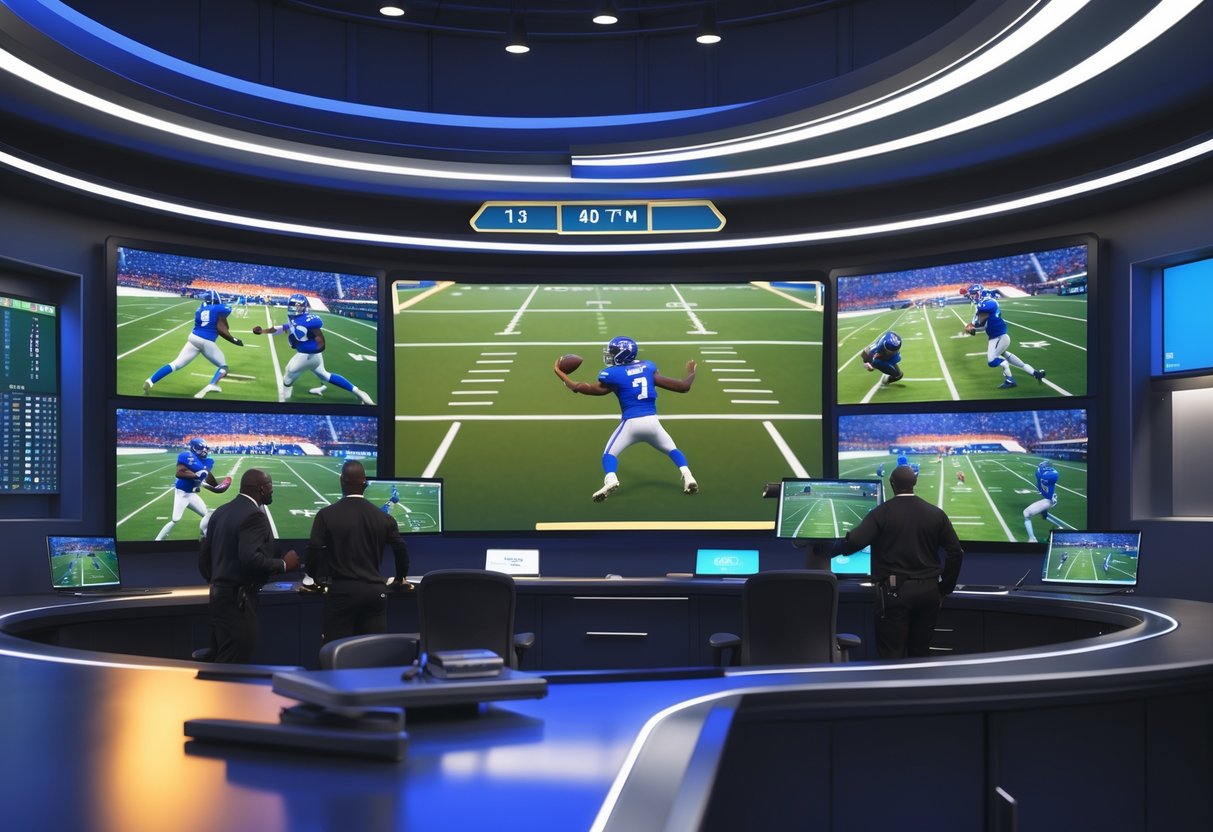
Replay officials need to check if a pass hit the ground and figure out if intentional grounding penalties apply when quarterbacks throw the ball away. These calls need clear criteria for ball control and specific rules about where quarterbacks can legally throw incomplete passes.
Distinguishing Between Incomplete and Completed Passes
We check for three main things when reviewing pass completions. The receiver has to get control of the ball, keep that control, and finish the catching process.
Control means the player really grips the ball. If the ball wiggles a little but stays in the receiver’s hands, we usually call that maintained control.
The catching process requires surviving contact with the ground. If a receiver catches the ball but loses it hitting the turf, that’s not a catch.
At the sidelines and end lines, we hold receivers to a higher standard. They must keep control through any ground or out-of-bounds contact.
Key review points:
- Did the ball hit the ground before the receiver controlled it?
- Did the receiver keep control during and after hitting the ground?
- Did the receiver finish the catching motion?
Multiple video angles help us see ball movement. Slow-motion replay shows if the ball shifted when it hit the ground or stayed secure.
We also check if any part of the ball touched the ground during the catch attempt. Even a little ground contact before full control can make the pass incomplete.
Criteria for Intentional Grounding
We call intentional grounding when quarterbacks throw incomplete passes on purpose to avoid sacks. The quarterback’s location matters—inside or outside the pocket.
From the pocket, any obvious throwaway is grounding unless there’s an eligible receiver in the area. The receiver doesn’t have to be able to catch it, just be reasonably close.
Outside the pocket, quarterbacks need to throw the ball past the line of scrimmage. This stops them from just dumping the ball or tossing it short with no receiver nearby.
Essential grounding elements:
- Quarterback faces an imminent loss of yards
- No eligible receiver is in the area
- Ball doesn’t cross the line of scrimmage (when outside the pocket)
- Pass looks obviously uncatchable
We look at how close receivers are when making these calls. If a receiver is within 10-15 yards of where the ball lands, it usually avoids a grounding penalty.
Spikes to stop the clock are legal and not grounding. The quarterback has to spike the ball right after the snap for this rule.
Relevant Video Review Scenarios
We can review if a pass is complete or incomplete with replay. But instant replay can’t review intentional grounding penalties.
Common review situations include boundary catches where receivers lose control. We check several angles to see if the ground knocked the ball loose.
End zone catches always get extra attention. Receivers must keep possession through ground contact or they haven’t scored.
If we overturn an incomplete pass ruling, the team that recovered the ball gets it. Any advance after recovery doesn’t count, and the ball goes to the recovery spot.
Review priorities:
- Ball-ground contact timing
- Receiver control through the catch
- Possession changes during ground contact
- Out-of-bounds timing
We can’t add intentional grounding penalties on review. If officials miss it on the field, replay can’t fix it.
Safeties create special cases. If intentional grounding happens in the quarterback’s end zone, we award a safety, no matter if the defence accepts the penalty or not.
Managing Loose Ball Situations
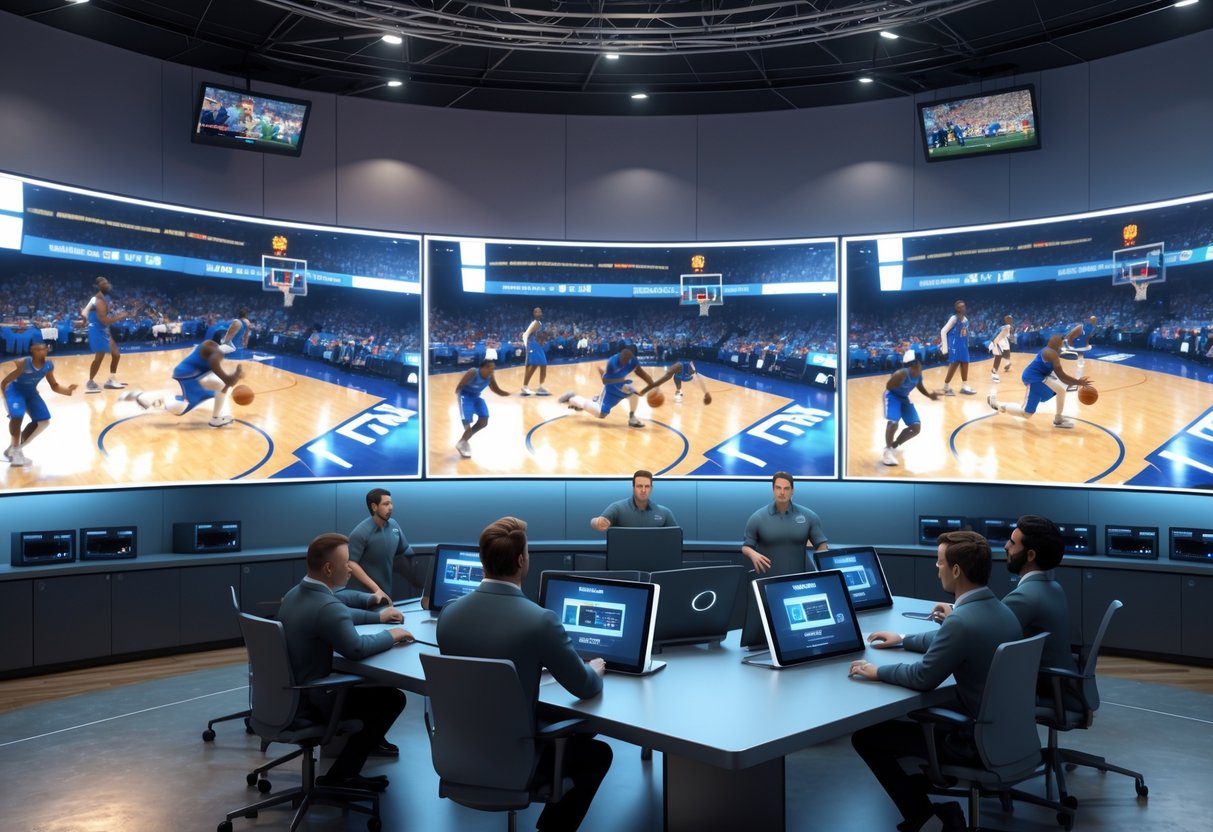
Loose ball situations are some of the toughest for replay officials. They need to figure out who had possession, if the ball crossed boundaries, and where the ball should be spotted.
Fumble and Recovery Reviews
Fumbles and recoveries are the trickiest loose ball situations. Officials first check if a fumble even happened or if the pass was incomplete.
Key Review Elements:
- Did the player control the ball before losing it?
- Did someone clearly recover the ball during the play?
- Did the ball go out of bounds after the fumble?
If replay overturns an incomplete pass to a fumble, the team that recovered gets the ball at the spot. Any advance after the recovery doesn’t count.
If the replay official can’t see who recovered the ball, the incomplete pass call stands. That way, officials avoid guessing in chaotic plays.
Recovery Requirements:
- Clear video proof of possession
- Confirmation from field officials
- Ball must be secured while play continues
Officials only review fumble recoveries when football action keeps going. If the whistle blew and ended the play, reviews don’t happen.
Loose Ball Out of Bounds
We handle loose balls out of bounds by focusing on exactly where the ball crossed the line. These reviews decide field position and possession.
Officials review if a loose ball hit the sideline, goal line, or end line. They also check if the ball hit a pylon or broke the plane of the goal line.
Reviewable Boundary Situations:
- Ball touching sideline markers
- Forward fumbles going out of bounds
- Loose balls crossing goal lines
- Ball touching pylons
When a loose ball goes out of bounds, the spot matters a lot. It affects down, distance, field position, and sometimes scoring.
Officials need clear video proof of the exact moment the ball crossed out. If they can’t see it, the original ruling stays.
Possession Determinations
We figure out possession by checking who really secured the loose ball. These reviews need clear proof of ball control and recovery.
Possession Criteria:
- The player must control the ball
- Control must happen inbounds
- Recovery must occur during live play
Officials can’t give possession to either team without obvious video proof. If there’s doubt, the dead ball or incomplete pass call stands.
For end zone catches and recoveries, we need to see the player keep control the whole time. Loose balls near the boundary need proof the player stayed inbounds.
Special Recovery Rules:
- Fourth down fumbles by anyone except the fumbler
- Kicks touched by players out of bounds
- Forward passes caught by ineligible players
Officials can put time back on the clock if possession changes affect the timing. This comes up most often in the last two minutes of each half.
Boundary and Line of Scrimmage Reviews
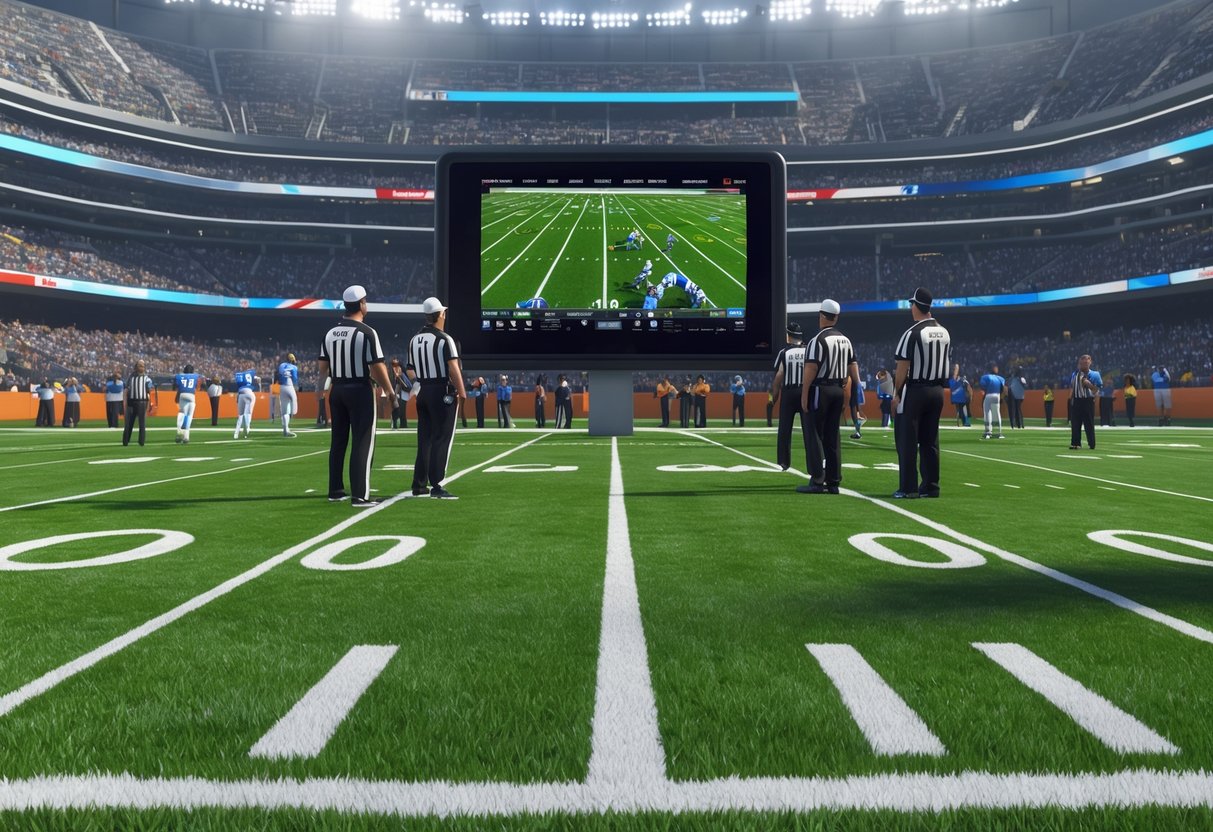
These reviews focus on exactly where players and the ball are in relation to key field markings. Officials check the footage to confirm if players crossed certain lines or if the ball reached the right spot.
Line of Scrimmage Positioning
The line of scrimmage is where every play starts. Picture an invisible line across the field, right where the ball landed after the last play.
Now, replay officials jump in to help with ball placement and player positioning at this line. They check if the offense lined up correctly before the snap.
Common review situations include:
- False start penalties
- Offside violations
- Illegal formation calls
- Ball spot corrections after runs
Officials rely on multiple camera angles to see exact positions. The replay assistance rule lets them make quick fixes without stopping the game for a long review.
Timing matters. Replay officials need to call in corrections before the play clock drops below 20 seconds.
This system helps set the right down and distance for the next play. It also makes sure penalties get enforced properly if someone crosses the line too soon.
Out of Bounds and Sideline Calls
Sideline plays can be a real headache for officials. They have to figure out if a player stepped out or if the ball crossed the line.
Replay assistance covers several tricky boundary situations. Think about loose balls touching the boundary or late hits out of bounds.
Key review areas:
- Receivers making catches near the sideline
- Running backs stepping out during a carry
- Fumbles rolling out of bounds
- Players being pushed out of bounds
The system now covers forcible contact with a runner who’s already out. Replay can help fix unnecessary roughness penalties in these cases.
Sideline cameras usually give a clear look at a foot on the white line. Officials can confirm things without much delay.
Player safety really comes into play here. Late hits out of bounds can lead to nasty injuries.
Goal Line and End Zone Boundaries
The goal line is football’s most important boundary. It decides touchdowns or field goals.
Replay officials watch goal line crossings with several camera angles. They look for the moment the ball breaks the plane.
End zone reviews cover:
- Touchdown scoring plays
- Touchback situations
- Safety calls in the end zone
- Incomplete passes versus catches
Officials also check for end line violations, like players stepping out the back of the end zone.
The replay assistance rule lets them fix the football’s exact spot in relation to a line. That means quick corrections for goal line stands and short-yardage plays.
Precise ball placement near the goal line can decide a game. Sometimes it comes down to inches on fourth down.
Modern cameras break down plays frame by frame. That really helps officials get the big calls right.
Penalty Enforcement in the Replay Process
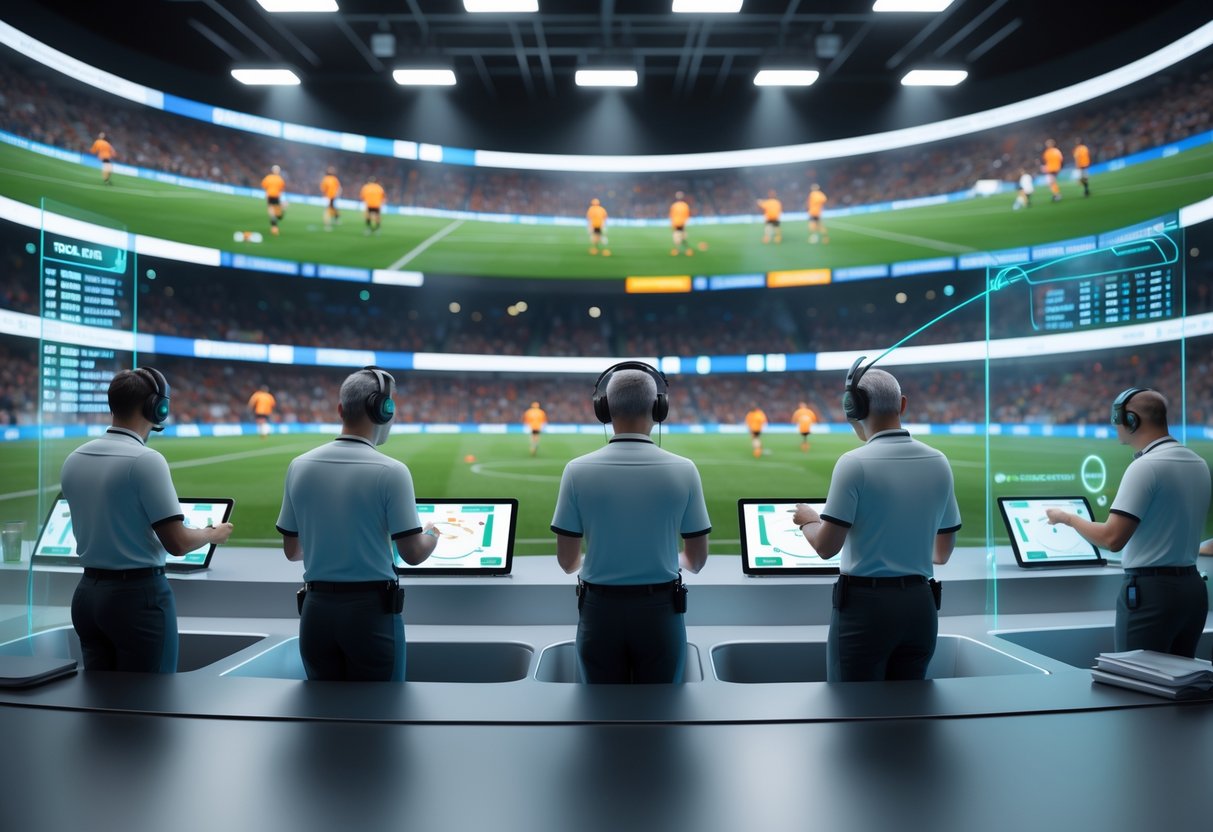
When replay officials overturn a call, penalties from the play don’t just disappear. Enforcement depends on what kind of foul it was and when it happened.
Reviewable Penalty Applications
Most penalties stay off limits for instant replay. We can’t use replay to check for holding or whether a player was offside.
But replay can fix certain penalty applications. Officials can check if a foul happened before or after a key event in the play.
What replay can address:
- Whether a penalty happened before the ball crossed the goal line
- If a foul occurred during a fumble or interception
- The right down number after penalty enforcement
Penalty timing really matters. A holding call before a touchdown changes things way more than one after the score.
When officials overturn the original call, they review penalties again based on the new outcome. This keeps enforcement fair no matter what the replay shows.
Spot of Foul Determinations
Replay helps officials figure out where to enforce penalties after a call gets changed. The enforcement spot shifts based on what actually happened.
Ball position and penalties get tied together. If replay shows a pass was caught, holding gets enforced from the catch spot, not the line of scrimmage.
Key enforcement changes:
- Live-ball fouls apply while the play continues
- Dead-ball fouls apply when the play ends differently than first thought
- Spot fouls move with the actual ball location
Picture this: Officials call a pass incomplete, but replay says it was caught. Now, any holding penalty gets enforced from where the catch happened.
The defense gets another shot to accept or decline penalties after a call gets overturned. That way, teams don’t get burned by a bad original ruling.
Unsportsmanlike Conduct Fouls
Personal fouls and unsportsmanlike conduct get special treatment in replay. These penalties stick, whether the original call stands or not.
Always enforced penalties:
- Targeting fouls against defenceless players
- Late hits after the whistle
- Taunting or excessive celebration
- Fighting or aggressive contact
If replay overturns a call, these penalties shift from live-ball to dead-ball fouls. The yardage still counts, but enforcement starts from a new spot.
Officials take these fouls seriously—they’re about player safety and sportsmanship. Even if the play changes, bad behavior brings consequences.
This keeps the game fair and puts player safety first, even during replay reviews.
The Impact of the Replay Review Process on Football
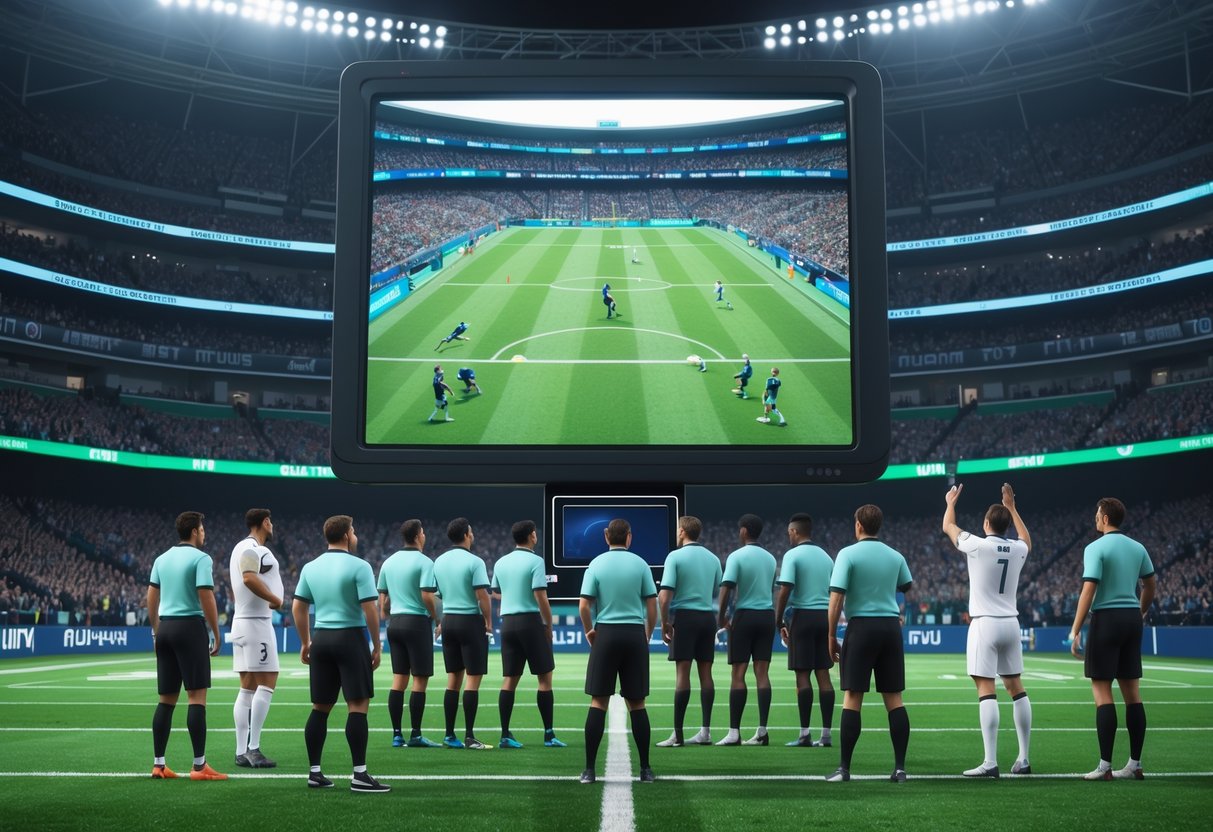
Replay review has totally changed how football gets officiated—and honestly, how fans watch it too. Technology upgrades and streamlined procedures have improved accuracy while trying to keep the game moving.
Advantages and Limitations
Instant replay brings major benefits to football officiating. There are fewer blown calls that could swing a game. The tech helps referees double-check tough decisions they might miss live.
Key advantages include:
- More accurate penalty decisions
- Better goal-line calls
- Fairer outcomes for teams
- Fans trust the refs more
Still, replay systems have their limits. Some calls just don’t get clearer, even with video. That “indisputable evidence” standard means close calls often stick with the original ruling.
Common limitations are:
- Subjective calls still spark debate
- Not every angle catches the action
- Officials see things differently
- Technology can’t fix every officiating problem
Replay works best for clear-cut stuff, like a ball crossing a line. It struggles more with judgement calls about contact or intent.
Speed and Efficiency in Game Play
Modern replay systems focus on speed. The NFL’s technology upgrades let replay assistants fix obvious errors without going through a whole challenge.
This approach cuts down on long stoppages. Quick corrections happen in the background as play continues. Only the really complicated calls stop the game for a big review.
Time-saving improvements include:
- Automated tech for clear calls
- Replay officials in central hubs
- Better communication tools
- Simpler review rules
Game flow stays smoother than it used to. Fans aren’t stuck waiting as much. Players keep their momentum with fewer breaks.
Improving Officiating Consistency
Centralised replay makes officiating standards more uniform. The NFL’s Art McNally GameDay Central uses the same tech and procedures for every game.
This cuts down on differences between officiating crews. No matter where teams play, the standards match up. Consistent training and tech mean similar calls get similar treatment.
Consistency improvements include:
- Standard review steps
- Shared tech at all venues
- Central oversight on decisions
- Regular training for officials
Subjective calls still vary, sure. But factual stuff—scoring plays, boundaries—looks way more consistent than before replay came along.
Best Practices and Future Developments

Replay review keeps evolving. Better guidelines, new tech, and possible rule tweaks are all on the table. The goal? More accuracy, fewer delays, and a smoother game.
Guidelines for Effective Review Processes
Replay works best with clear, tested guidelines that balance accuracy and speed. The best systems ask managers to challenge plays within 15 seconds.
That short window keeps things moving. Quick decisions keep fans engaged and the game rolling.
Centralised review centers are now the gold standard. MLB’s New York facility shows how expert officials with all the camera angles can make faster, more consistent calls than just relying on the field crew.
Officials now train with replay scenarios all the time. They practice spotting reviewable plays and communicating calls clearly.
Heads up: If the review system gets too complicated, it just confuses everyone. The best practices keep things streamlined instead of reviewing every little thing.
Teams do better when replay rules spell out specific situations. Calls like fair/foul, timing, and tags need clear definitions to avoid messy results.
Emerging Technologies in Video Review
Artificial intelligence is shaking up how we review video evidence. AI-powered systems track player movements, ball paths, and timing with crazy precision.
High-speed cameras now capture thousands of frames per second. That means tight calls show up in detail regular video just can’t match.
360-degree camera arrays cover every angle at once. Officials can see plays from spots that old TV cameras missed.
Motion capture tech, borrowed from movies and gaming, helps pinpoint exactly where and when contact happened. These systems can measure distances down to millimeters.
Machine learning algorithms are being tested to flag controversial plays before anyone even challenges. That helps officials get a jump on tough decisions.
Real-time data now combines video with sensor info from gear and stadiums. This builds a full picture that goes way beyond what cameras can do alone.
Potential Rule Changes on the Horizon
Some big rule changes are being discussed to make replay even better. Expanding reviewable plays to include more subjective stuff could cut down on human error in big moments.
Automatic review triggers for high-stakes situations might get rid of manager challenges altogether. That way, key calls always get a second look, no gamesmanship needed.
Review time limits will probably get tighter. Nobody wants replay to drag out and kill the game’s pace.
A few leagues are thinking about limited appeals systems—teams could challenge a review with more angles or expert opinions.
Fan engagement features might let spectators watch review footage in real time, either on their phones or on stadium screens. That kind of transparency could help fans accept tough calls.
Rule changes could also set when reviews happen. Maybe late-game restrictions or automatic reviews for scoring plays will replace the current challenge system.
The focus stays on fairness and game integrity, but also on keeping the sport’s unique flow and vibe.
Frequently Asked Questions

Replay review systems work differently in every sport. Each one has its own rules for challenging calls and reviewing plays. Most sports limit when teams can ask for reviews, and trained officials use video to make the final call.
How does the umpire’s decision review system work in cricket?
In cricket, the Decision Review System (DRS) lets teams challenge the on-field umpire’s call. Each team gets a set number of reviews per innings, and they lose one if their challenge fails.
The third umpire checks the play using different camera angles and technology like ball-tracking. They look at things like whether the ball hit the bat first or if it would’ve hit the stumps.
The third umpire then tells the on-field umpire the result, and that umpire announces the final call. The whole process usually takes two or three minutes.
Could you explain the steps involved in a video replay review in football?
In American football, coaches challenge calls by tossing a red flag onto the field. Each team gets two challenges per game, and a third if they get both right.
The referee checks the play on a handheld monitor, using all available camera angles. They’re looking for clear evidence to overturn the call.
If the video isn’t clear, the original call sticks. Coaches lose a timeout if their challenge doesn’t work out, so there’s real strategy involved.
What protocols are followed during the tennis match when a player challenges a line call?
Tennis uses the Hawk-Eye system for line calls. Players can challenge a call a limited number of times per set and have to do it right after the point.
The system shows a 3D replay of the ball’s path and where it landed. Everyone in the stadium sees the result within seconds.
If the challenge works, the player keeps their remaining challenges. If not, they lose one for that set.
In which sports is the replay review process most critical and commonly used?
Cricket, American football, tennis, and baseball all lean pretty hard on replay systems. These sports often come down to split-second calls that can swing the entire match.
In cricket, the DRS helps sort out tricky LBW appeals and those caught-behind moments. Tennis has its own tech for line calls—honestly, sometimes it’s impossible for anyone to see if that ball clipped the line.
Baseball checks plays at bases, home runs, and those fair or foul balls that spark endless debates. Each sport has found its own way to use replay tech for the calls that stir up the most controversy.
What is the role of the third umpire in reviewing decisions made on the field?
The third umpire usually sits away from the action, watching everything through a bank of screens. They get all the camera angles and replay tech you could ask for.
If someone requests a review, the third umpire digs into every replay they’ve got. Slow-motion footage and different angles help them catch details the on-field officials might miss.
Once the third umpire makes the call, they pass it along to the folks on the field. Those officials then let the players and the crowd know what’s up. This whole setup adds another layer of accuracy to the big decisions.
When can a team or player request a review of the play in American football?
Coaches usually challenge most referee calls, but they can’t do it during the last two minutes of each half.
In those tense moments, only the replay assistant steps in to start reviews.
Teams aren’t allowed to challenge certain plays, like penalties for unsportsmanlike conduct or false starts.
The officials automatically review scoring plays and turnovers, so coaches don’t need to throw the red flag for those.
Each team gets two challenges to start, and if a challenge fails, they lose a timeout.
If a team wins both challenges, they earn a third shot at challenging a call.


